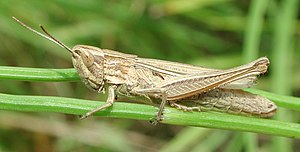White-rimmed grasshopper
| White-rimmed grasshopper | ||||||||||||
|---|---|---|---|---|---|---|---|---|---|---|---|---|

White-rimmed grasshopper |
||||||||||||
| Systematics | ||||||||||||
|
||||||||||||
| Scientific name | ||||||||||||
| Chorthippus albomarginatus | ||||||||||||
| ( De Geer , 1773) |
The white-rimmed grasshopper ( Chorthippus albomarginatus) belongs to the grasshopper subfamily and is widespread in Germany.
features
White-rimmed grasshoppers are very variable in color. Depending on the habitat, they can be greenish to dark brown. Mixed colors also often occur. The males are always smaller (13 to 15 mm) than the females (18 to 21 mm). Her forehead is slightly depressed or flattened in a rhombic shape in front of the eye. The antennae are not thickened at the end and are thread-like. The hind legs do not have a yellowish ring. The side keels of the rear shield are parallel or slightly trapezoidal. Their wings are always fully developed, almost as long as the abdomen, but do not reach the rear knees (which are light and hardly darkened). The animals can not only hop, but also use their wings to fly briefly. The hind wings are only slightly shorter than the front and do not purr when they fly up. The forewings, however, are about 5 times as long as they are wide. In the forewing, the second longitudinal artery is clearly wavy from the front.
Sex dimorphism prevails : male and female animals differ from each other. The females are always larger. Their forewings are narrower than their hind legs. The upper laying sheath flaps (which only occur in females) are gradually sloping towards the tip at an angle of about 45 °. The front edge of the front wing is usually provided with a yellowish-white longitudinal line in the females. The males, on the other hand, have forewings that are about as wide as the hind legs. They also have a cone-shaped abdomen.
There is a risk of confusion with the meadow grasshopper ( Chorthippus dorsatus ).
Occurrence
The animals are found on wet meadows, pastures, dunes and salt marshes from the lowlands to the low mountain ranges. They are less common in the south of Germany, but widespread and frequent in the north. The adults appear from about mid-June to the end of September.
Way of life
In autumn the adult animals prefer to lay their eggs in the ground or between flowers near the ground. This winter and in June / July to slip it then imagines . In very hot years they can hatch earlier, depending on the temperature. Singing (see below) usually only takes place on very warm, sunny days.
They can be recognized by their loud singing (individual short whirring sounds “shrill” at a distance of a few seconds, audibility approx. 10–20 meters). In the direct vicinity of females, the males stridulate very quietly (audibility approx. 50 cm) and with slower alternating leg movements. They can be distinguished from the species Chorthippus dorsatus (meadow grasshopper), which is very similar in appearance .
literature
- Heiko Bellmann: Locusts: observe, determine , Naturbuch Verlag 1993, ISBN 3-89440-028-5
- Heiko Bellmann: grasshoppers. The voices of 61 native species. CD, Amp Europe 2004, ISBN 3-935329-48-2
- Siegfried Ingrisch, Günther Köhler: The locusts of Central Europe , Westarp Sciences 1998, ISBN 3-89432-461-9
- Peter Detzel: Locusts of Baden-Württemberg , Ulmer Verlag Stuttgart 1998, ISBN 3-8001-3507-8
- Josef Szij: The jumping horrors of Europe , The New Brehm Library Volume 652, Westarp Sciences Hohenwarsleben 2004, ISBN 3-89432-910-6
- Heinrich Tauscher: Our locusts , Kosmos Franckh'sche Verlagsbuchhandlung Stuttgart 1986, ISBN 3-440-05617-1




